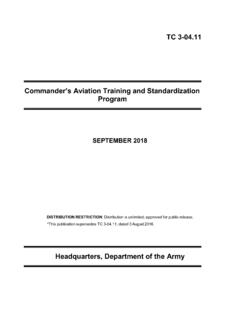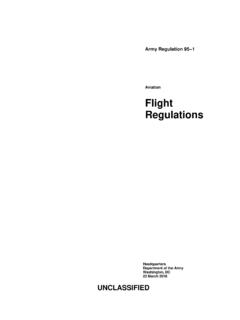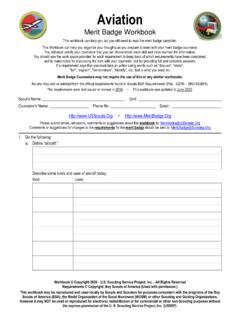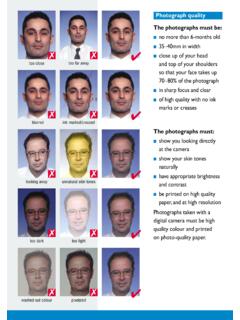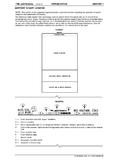Transcription of Advisory - Federal Aviation Administration
1 Department of Transportation Federal Aviation Administration Advisory Circular Subject: FAA Approval of Aviation Training Devices and Their Use for Training and Experience Date: 9/12/18 AC No: 61-136B Initiated by: AFS-800 Change: 1 PURPOSE OF THIS Advisory CIRCULAR (AC). This AC provides information and guidance for Aviation Training Device (ATD) manufacturers seeking Federal Aviation Administration (FAA) approval of a basic Aviation training device (BATD) or advanced Aviation training device (AATD) under Title 14 of the Code of Federal Regulations (14 CFR) part 61, (c). This AC also provides information and guidance for those persons who intend to use a BATD or AATD for activities involving pilot training and experience, other than for practical tests, aircraft-type-specific training, or an aircraft type rating.
2 This AC contains specific procedures regarding the evaluation, approval, and use of an ATD under 14 CFR parts 61 and 141. The criteria specified in this AC are used by the FAA to determine whether an ATD is qualified for approval as a BATD or an AATD. These guidelines have developed from extensive FAA and industry experience in determining methods of compliance with the pertinent 14 CFR regulations. Applicable regulations are noted only for reference. This AC does not change regulatory requirements; therefore, the provisions of the current regulation always control. This AC applies only to the evaluation and use of BATDs and AATDs. This notice does not apply to full flight simulators (FFS) and flight training devices (FTD) that are regulated under 14 CFR part 60. 2 AUDIENCE. ATD manufacturers, authorized instructors, flight training providers, pilots, and others involved in flight training and operations under part 61 or 141 should be familiar with the content of this AC.
3 ATD Assessment. A new ATD must be satisfactorily assessed in the areas essential to airman training fundamentals to the extent described in: Appendix A, General Information; Appendix B, Basic Aviation Training Device (BATD) Requirements; Appendix C, Advanced Aviation Training Device (AATD) Requirements; Appendix D, Training Content and Logging Provisions; and Appendix E, Evaluation and Subjective Test Criteria. Required Function, Performance, and Effective Use of ATDs. This AC provides information and guidance for the required function, performance, and effective use of ATDs for pilot training and aeronautical experience (including instrument currency). ATDs cannot be used for practical tests, aircraft type specific training, or for an aircraft 9/12/18 AC 61-136B type rating. Manufacturers of these devices meeting the guidance and standards provided in this AC will receive a letter of authorization (LOA) from the FAA Flight Standards Service s (FS) General Aviation and Commercial Division approving them as either a BATD or an AATD.
4 The LOA will be valid for a 5-year period with a specific expiration. 3 WHERE YOU CAN FIND THIS AC. You can find this AC on the FAA s website at 4 WHAT THIS AC CANCELS. AC 61-136A, FAA Approval of Aviation Training Devices and Their Use for Training and Experience, dated November 17, 2014, is canceled. 5 RELATED 14 CFR PARTS. Part 61, , , , , , , and Part 141, , , and , and appendices B, C, D, E, F, G, I, K, and M. 6 RELATED READING MATERIAL (current editions). FAA-S-ACS-6, Private Pilot Airplane Airman Certification Standards. FAA-S-ACS-7, Commercial Pilot Airplane Airman Certification Standards. FAA-S-ACS-8, Instrument Rating Airplane Airman Certification Standards. FAA-S-8081-4, Instrument Rating Practical Test Standards for Airplane, Helicopter, and Powered Lift. FAA-S-8081-5, Airline Transport Pilot and Aircraft Type Rating Practical Test Standards for Airplane.
5 FAA-S-8081-15, Private Pilot Practical Test Standards for Rotorcraft. FAA-S-8081-16, Commercial Pilot Practical Test Standards for Rotorcraft. FAA-S-8081-20, Airline Transport Pilot and Aircraft Type Rating Practical Test Standards for Helicopter. FAA Order , Volume 11, Chapter 10, Section 1, Approval, Oversight, and Authorized Use Under 14 CFR Parts 61 and 141. 7 BACKGROUND. Continuing development in computer flight simulation and visual displays have led to popular use of flight simulation training devices (FSTDs) and ATDs in General Aviation (GA). The GA community is using this evolving simulation technology to provide increasingly effective pilot training at reduced cost. This AC reflects the FAA s experience with ATD flight simulation technology used to meet specific regulatory flight training and experience requirements of parts 61 and 141.
6 Flight Procedures, Tasks, and Operational Skills. Flight instructors have typically taught procedural skills and tasks during in-flight training. However, the FAA has 2 9/12/18 AC 61-136B determined that instructors can successfully teach many of these procedural skills and tasks during ground training using ATD simulation. The FAA recognizes that flight instructors can effectively teach many operational skills ( , instrument flying, traffic patterns, stabilized approaches, emergency procedures, etc.) using ATDs. These procedural and operational skills can then be positively transferred to successful operations in aircraft. Information on integrating ground training using an ATD with flight training can be found in Appendix D. Evaluations of ATDs. The FAA has evaluated many flight simulation systems and applications for ATDs.
7 These evaluations determine whether the elements and tasks of pilot training and other experience requirements described within part 61 or part 141 can be successfully accomplished using ATDs. Pilots and instructors may use ATDs in accordance with the LOA to meet certain training and aeronautical experience requirements listed in part 61 or part 141. 8 ACTION. Manufacturers can use this AC as a method of compliance to satisfy the requirements to obtain FAA approval of their ATD. The criteria listed in Appendix B is exclusively for BATDs and the criteria listed in Appendix C is for additional items required for AATDs. When the FAA determines that an ATD qualifies, an LOA will be provided to the manufacturer specifying the training credit allowances. All approvals for pilot training and experience, including approvals for use under parts 61 and 141, must be in accordance with criteria specified in this AC and the LOA.
8 9 AUTHORIZATIONS FOR PREVIOUSLY APPROVED DEVICES. Training Devices Not Approved by the National Simulator Program (NSP) Branch. All FAA-approved training devices not evaluated or approved by the NSP Branch in Atlanta, GA (under part 60) come under the evaluation, approval, and policy of the General Aviation and Commercial Division. All ATDs will require reauthorization on a 5- year schedule. This evaluation ensures that current standards and criteria identified by this AC continue to be met. Previous Authorizations Not Issued by the General Aviation and Commercial Division or That Do Not Contain an Expiration Date. All approvals for ground trainers, simulators (except for FFS Level A D and FTD Levels 4 7), FTDs Level 1 3, personal computer-based Aviation training devices (PCATD), and ATDs with authorizations that were either not issued by the General Aviation and Commercial Division, or do not contain an expiration date, terminated on December 31, 2015 as described in Federal Register (FR) Docket No.
9 FAA-2013-0809, Notice of Policy Change for the Use of FAA Approved Training Devices. A manufacturer or operator may submit an application letter as described in this AC in pursuit of a new LOA. See Appendix A, paragraph , Previously Approved Devices, for additional information. 3 9/12/18 AC 61-136B 10 AC FEEDBACK FORM. For your convenience, the AC Feedback Form is the last page of this AC. Note any deficiencies found, clarifications needed, or suggested improvements regarding the contents of this AC on the Feedback Form. Michael Zenkovich Deputy Executive Director, Flight Standards Service4 9/12/18 AC 61-136B Appendix A APPENDIX A. GENERAL INFORMATION Information Requests. Inquiries regarding the evaluation, approval, and use of ATDs should be directed to FAA Flight Standards Service, General Aviation and Commercial Division, Airmen Certification and Training Branch (AFS-810), 800 Independence Avenue, , Washington, DC 20591.
10 Contact information can be found at Definitions. Aviation Training Device (ATD). An ATD is a training device, other than a full flight simulator (FFS) or flight training device (FTD), that has been evaluated, qualified, and approved by the Administrator as a basic or advanced ATD (refer to 14 CFR part 61, ). In general, this includes a replica of aircraft instruments, equipment, panels, and controls in an open flight deck area or an enclosed aircraft cockpit. It includes the hardware and software necessary to represent a category and class of aircraft (or set of aircraft) operations in ground and flight conditions having the appropriate range of capabilities and systems installed in the device as described within this AC for the specific basic or advanced qualification level. Basic Aviation Training Device (BATD).










